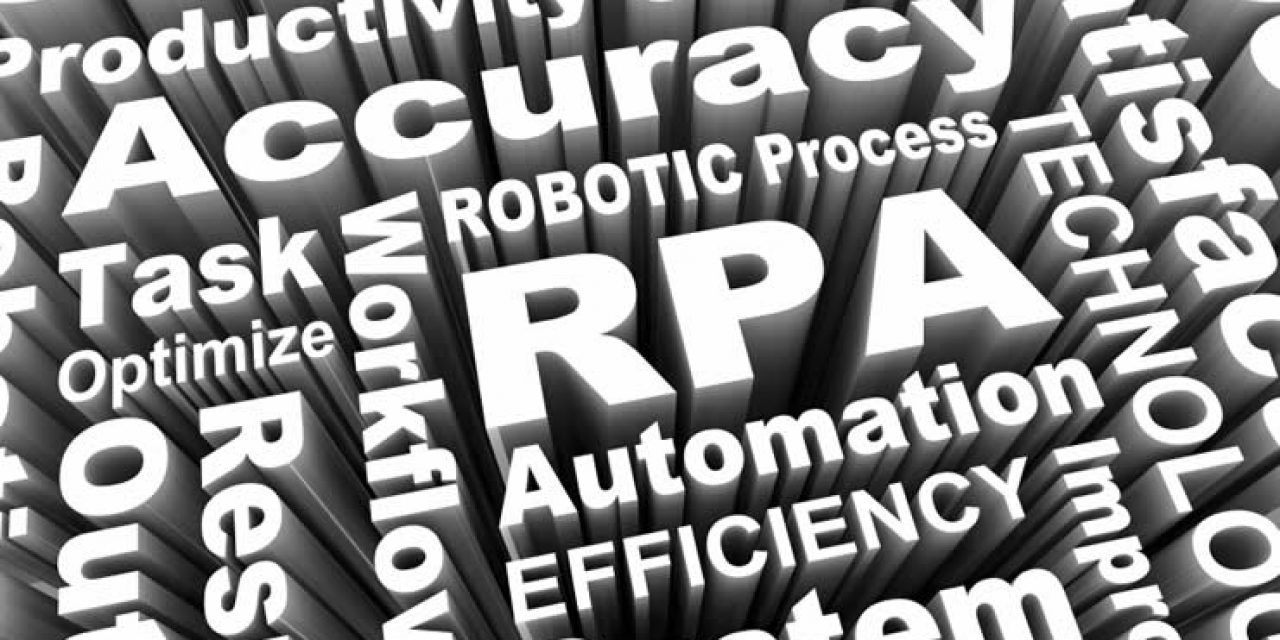Robotic process automation (RPA) offers several benefits over traditional automation solutions. It enables to save costs and free up resources with a low non-invasive technical barrier. Increased productivity, higher accuracy (and less errors), the ability to streamline regulatory compliance, faster service (and thus enhanced customer satisfaction) and higher consistency are other advantages. An overview of robotic process automation for business and digital transformation.
Robotic process automation or RPA is the development and deployment of software robots or bots to automate rules-based and repetitive mundane tasks performed by people within workflow and process-related applications (often legacy systems) and operations.
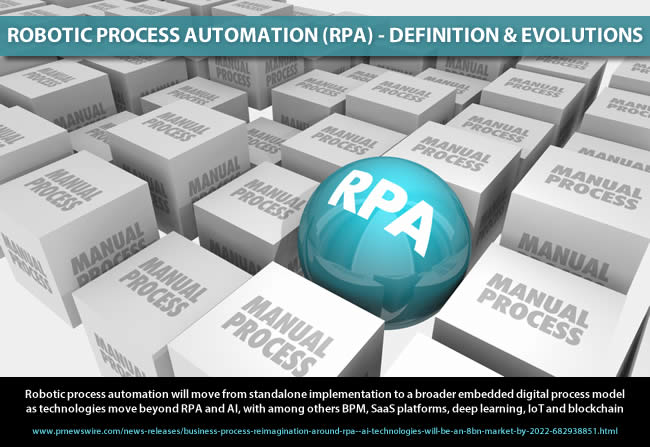
Robotic process automation describes both the software which is used to robotize processes as the practice (or process as such) of defining processes and tasks that are best suited for RPA and the strategic approach to effectively design and apply the RPA script, macros and algorithms to the process.
Robotic process automation emulates human execution of repetitive processes with existing applications by using software robots which are configured to capture and record these applications in order to process transactions, manipulate data, trigger responses and communicate between different digital systems.
The software robots enabling Robotic Process Automation (RPA) can simulate manual input commands which are traditionally performed by knowledge workers using, for example, their mouse or keyboard.
So, at the core, robotic process automation enables to replicate how people conduct repetitive tasks in an application (e.g. entering data, performing transaction-related tasks). It’s in automating these repetitive tasks that the scripts, macros, algorithms and evolutions come in. The replication is based upon user interface interactions (it looks at how people use the specific application that of course has a user interface so it can be used for the ‘to be automated’ task to begin with).
For the sake of understanding, imagine a “real” physical robot sitting next to a worker, ‘learning’ how the worker performs a routine task within a process-related application (what happens on the screen of the computer) and in the end, being able to do all that as if it were a worker. The difference is that with robotic process applications there are no physical robots involved (they won’t start typing or using a mouse) and the logic is in the software robot instead.
Robotic process automation in the intelligent process automation journey
Robotic process automation is about software, process automation, logic, and, soon, integration with other technologies in a new environment and digital process approach as we’ll tackle.
Robotic process automation is also more than technology: there are clear strategies and steps to follow. However, the integration with specific forms of artificial intelligence is where most people look at, which is an even further step on the road to intelligent process automation.
As opposed to traditional automation solutions, robotic process automation uses existing user interfaces
Intelligent process automation, as anything called intelligent these days, is the journey towards process automation leveraging artificial intelligence in its fullest way. We are far from there yet and even only starting with the integration of AI and RPA.
RPA has more in common with bots as you know them from, among others chat bots, and with “robotic” software as you might know it from robo-advisers in financial technology. The additional component is the replication of what the user does and thus the graphical user interface with RPA also having its roots in screen scraping. Do note that there is a ‘human’ user that manages the software robot once it’s ready for deployment and after that.
RPA certainly isn’t a solution for all process automation needs either, just as chat bots aren’t a replacement for other forms/channels/technologies of customer service and robo-advisers are not a replacement for financial advice (providers of such applications have started to offer other means of interaction because they had too).
Robotic process automation is not very intrusive or hard from an IT viewpoint, is relatively low-hanging fruit, exists since several years and is a logical evolution in process automation, building upon existing technologies and possibilities. As a non-invasive technology with high saving potential (see below) RPA is increasingly adopted although there are differences across various markets and regions. While some companies are starting others are already moving to the next stage of integrated automation where RPA fits in. In other words: RPA is in flux, both from an adoption and vendor perspective with the latter being a move to integration.
Robotic process automation and AI
While robotic process automation traditionally works more on the back-office level and artificial intelligence in making sense of unstructured data for the front-office level, the expectations for the integration of AI and RPA before moving to intelligent process automation are high.
This isn’t really that surprising either and fully in line with what you see happening in other areas such as IoT (the Internet of Things, where IoT and AI integration is a hot topic too since without AI you can’t fully leverage IoT), the evolutions in ERP (with i-ERP) where you see the same technologies becoming integrated (with, on top of it, blockchain, that will also play a role in the typical markets for robotic process automation) and the evolutions in IoT platforms (in the end, also information systems) where support of AI engines simply becomes a must. Integration is the name of the game everywhere and integrated automation is also the next step in which RPA will become a part of a broader approach and we enter the realm of intelligent automation with several forms of AI such as machine learning, visual recognition and heuristic neural networks adding to the capabilities of RPA and, among others, its ability to combine scenarios, increase understanding, and make real-time predictive decisions as Dimension Data puts in a customer experience context.
Robotic process automation: the benefits
There are several benefits in leveraging RPA and in combining AI and RPA. We’ve mentioned some before.
De facto most benefits really more or less overlap with or are similar to those cited for automation overall. Below we tackle some benefits of robotic process automation. For a more complete and visual overview check out the graphic by EY below and read the EY article about RPA (PDF downloads).
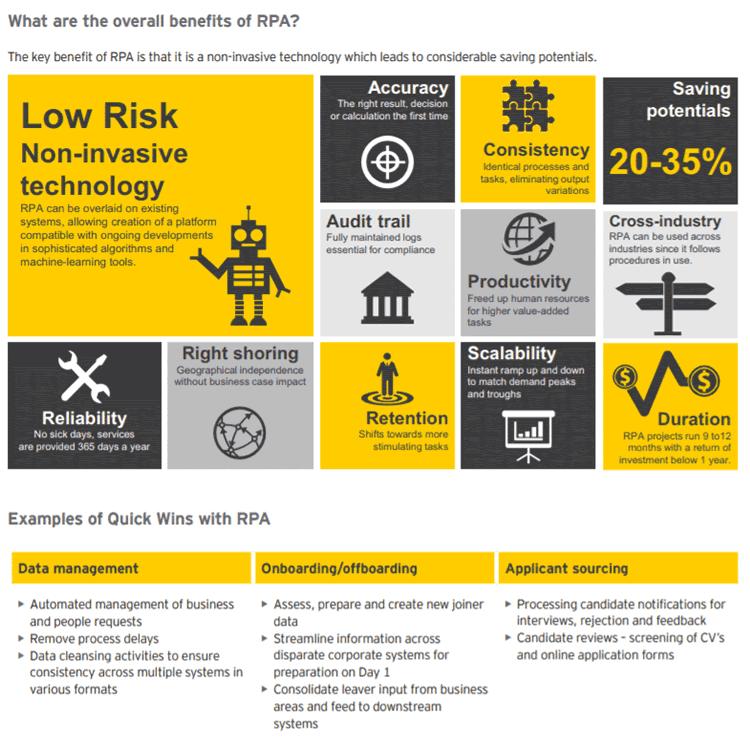
Reducing the “pains” and costs of repetitive tasks
This is one such benefit mentioned for all forms of automation.
In theory and, when done in a smart holistic way within a ‘real’ digital transformation scope, it also means that workers can focus on higher-value tasks.
However, as per usual de facto this often really means saving on employee costs by reducing the number of FTEs, even if there is someone to manage the software robot or ‘virtual employee’ as some tend to call the robotic process automation ’employee’ (e.g. also checking for exceptions etc., in the essential form). On the human and ‘digital work’ level, there are of course organizations that don’t just focus on replacing FTEs as well.
Higher customer and employee satisfaction
This boils down to the same benefit with the additional element of speeding up processes in times of impatient customers and the inherent demands of the real-time economy.
Robotic process automation indeed can lead to higher customer satisfaction this way and can also lead to higher employee satisfaction in companies where RPA of course is not (just) a matter of reducing FTEs.
Robotic process automation plays an important role in the customer service (and contact center) industry and is expected to transform both the back office and front office. RPA offers agents the assistance needed to enhance productivity, by allowing staff to focus more on helping customers instead of spending too much time on navigating systems or post-contact wrap up as Dimension Data puts it in a report.
Moreover, RPA improves quality by decreasing errors of manual data entry, decreasing rework, speeding up customer handling and reducing complaints. This of course isn’t all that surprising since there’s pretty much always a customer at the outcome of a process. For these and other reasons Dimension Data says RPA is reshaping customer experience.
Enhanced quality, productivity and efficiency
The robotic process automation (and in general automation) benefits of productivity and efficiency are well known too and also relate to employees (higher revenue per FTE, less salaries to pay) and to customers (speed) and the connected real-time and as-a-service economy.
The enhanced quality depends on the type of process and related tasks that get automated (data processing and data-related tasks, customer service related tasks, information and workflow automation in customer onboarding tasks, invoice processing, cross-system tasks etc.).
Less room for error, higher accuracy
Robotic process automation, when of course properly done, reduces the possibilities of errors across any given task as essentially the human “error” element is replaced.
Less errors means less costs, less wasted time, higher accuracy and, depending on the process increased regulatory compliance where errors could have important consequences (e.g. personal data related tasks) and far more, which brings us to regulatory compliance (GDPR being one of many), a topic on its own almost in RPA.
RPA: the regulatory compliance picture
According to the 2018 Financial Services Industry Survey Report by Kofax and Digital Banking Trends, 30 percent of respondents (in leading financial institutions) expect 30%+ increases in the use of Robotic Process Automation across numerous compliance functions.
Quote: “The 2018 Financial Services Industry Survey Report confirms numerous compliance functions, from initial inquires through customer off-boarding, as key challenges for financial institutions, with 91% citing the “time/cost required from concept to reality” and 86% pointing to “budget constraints” as primary impediments. To combat these challenges, respondents expect substantial increases in the use of Robotic Process Automation software across numerous compliance functions, from 41% in document gathering to 32% in customer off-boarding”.
The role of robotic process automation in compliance (and beyond) also shows in the evolutions in forensic data analytics as previously reported in coverage of the third biennial EY Global Forensic Data Analytics Survey, 2018: 14 percent of respondents said they used robotic process automation to manage legal, compliance and fraud risks. Another 39 percent was likely to do so in the next 12 months.
Robotic process automation and digital transformation
As mentioned, not all business processes are candidates for robotic process automation. The list will expand as the addition of artificial intelligence continues and various forms of robotic process automation continue to be established on top of the “original simple” RPA approach.
Then it’s not just a matter of removing repetitive tasks but also of advanced analytics and the dream of all automation: semi-autonomous and autonomous decisions in processes, indeed just like in anything related to Industry 4.0, Logistics 4.0 and similar “transformational” evolutions. AI-based decision-making, human, semi-autonomous or autonomous taps into additional information sources, including external ones.
Let’s take a look at the true meaning and purpose of industrial transformation and digital transformation – and the role that business process automation and robotic process automation play in it all.
The goals (it is a journey) are and should be innovation, creating new sources and ecosystems of value and enhancing experiences across the board. De facto, however, many organizations, both in digital transformation and industrial transformation and certainly in robotic process automation remain stuck in internal optimization and cost cutting goals.
While transformation does require budgets that need to come from somewhere (organizations can plan in a staged way but cutting costs de facto indeed offers room for transformation), those that remain stuck in the pure cost reduction and productivity picture without having a broader digital transformation strategy, ecosystem approach and holistic perspective, putting people first, will fail in the longer run.
In this sense we see the same in robotic process automation as we see in digital transformation, industrial transformation and so on: reducing costs is a far more important de facto goal than innovating and creating platforms of revenue. This highly contributes to the huge increase in attention for robotic process automation and its possibilities and evolutions since, give or take, 2015-2016 and the current hype whereby reducing labor and FTEs comes back.
This of course goes for automation overall. In an article on the impact of the GDPR on the sourcing market in EMEA where we covered some findings from ISG (Information Services Group) we mentioned the 1Q18 Global ISG Index (SlideShare) showing that among the 5 mega-trends impacting the sourcing industry is the fact that 20 to 40 percent of labor is already removed through extensive automation.
For organizations wanting to leverage robotic process automation and what comes after it, it’s key to look at the bigger picture and, even if robotic process automation initiatives can be implemented relatively fast, to work in a staged way with pilots and gradually automating where it makes sense in the overall digital transformation value generation and innovation scope, rather than in ad hoc legacy system automation fix or standalone implementations.
Digital transformation remains key in it all. According to the mentioned Q1 ISG Index 2018, (which measures commercial outsourcing contracts with ACV of $5 million or more), the strong demand for digital transformation services boosted the overall global sourcing market in the first quarter of 2018 with ACV for the first time ever exceeding $12 billion.
And according to Appian digital transformation readiness 2018 research we covered previously, robotic process automation (in which Appian is a player) is in the top 5 areas of digital transformation that organizations intend to drive toward throughout 2022. The others? AI, IoT, natural language processing (NLP) and VR.
The future of robotic process automation: part of a bigger digitalization and integrated automation picture
In the future of robotic process automation standalone implementations which often indeed are automation fixes in legacy systems, are replaced by others as we continue moving to new systems, service approaches (whether it concerns financial applications, ERP, HR tools, content management systems and the very outdated view regarding content management) and re-engineered digital process models and solutions with more embedded technologies (whereby RPA gets embedded too) in the as-a-service economy of platforms of platforms and services.
While some see robotic process automation and the AI-based next stages in the intelligent process automation field replacing business process outsourcing or as the new business process outsourcing, more is indeed on the horizon on the longer term such as that rethinking of digital business processes where several technologies also get integrated as is the case in ERP. Yet, it’s clear that with RPA and AI technologies there is a new phase in outsourcing.
As NelsonHall emphasizes when looking at RPA and AI, this is rather a boost for the BPO market than an end of it. However, it does disrupt the BPO space, once more showing that those BPOS focusing on the overall digital transformation goals and/or specializing in specific domains will benefit from it.
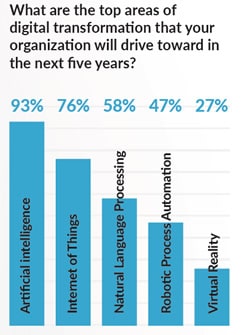
Simply put and it can’t be repeated enough: digital transformation drives the agenda; vertical expertise is key to move higher up the BPO value chain as well and looking at as-a-service models instead of traditional BPO approaches is essential for survival with ecosystems and the move to services in platforms as additional necessities. If you compare with the dot com period saying, “get big, get niche or get out” you could say get up in the value chain, get niche, get involved in rethinking business processes with ecosystems and services focused on IT AND the business or get out”.
This comes back in the mentioned forecasts of NelsonHall: “RPA will move from standalone implementation to a broader embedded digital process model as technologies move beyond RPA and AI, with among others BPM, SaaS platforms, deep learning, IoT and blockchain”.
Yet, for now, as NelsonHall states, organizations face the immediate roadblock in their automation journeys of handling classification of documents and processing of unstructured data before taking “a massive leap to re-imagine processes and introduce new digital process models”.
The aspect of focusing on IT AND the business or, better, understanding very well what both want and need, isn’t just key to succeed in robotic process automation but also in remaining relevant as a BPO as organizations want you to understand their business and transform. Robotic process automation is becoming part of an integrated automation approach with, for example, RPA, AI, case management and more functions within one – connected – proposition.
Where robotic process automation makes sense: processes, use cases, industries and beyond
Finally, from a ‘types of processes’ and ‘types of industries, use cases and applications’ perspective we mainly see robotic process automation in following areas.
Processes fit for RPA
Processes where chance of human error is high, legacy systems are in place, routine tasks and essential transactions are involved, human involvement isn’t strictly needed, high volumes (and many process and manual tasks) are concerned and staff indeed can generate far more value where it matters: in human interactions.
In customer service, for instance, one of the areas where we’ve seen loads of automation and digital tools such as chatbots and self-service tools, the need for human interaction with knowledgeable and empowered staff is high, one of the areas where it’s clear that people want people when it matters (as we saw with robo-advisers).
Examples of processes: procure to pay, human resources, onboarding (of customers, employees, patients, providers and more), simple IT-related and data-related tasks and various types of transactions.
Robotic process automation on an industry level and beyond
On the level of industries, use cases and applications, on top of customer service and the financial services industry (including insurance) where robotic process automation is hot (the financial services industry is also the main market for sourcing services), there is the telecommunications and media sector, manufacturing and utilities, retail and more.
The healthcare industry, finally, rises fast in sourcing in general and also in robotic process automation. In an older article on how healthcare providers and payers boost digital transformation deployments we mentioned how robotic process automation and process reengineering, among others, ranked quite high in planned initiatives on the healthcare payers side according to IDC.
Robotic process automation is part of the business process management and automation toolkit, working hand in hand with other applications. So, of course it has an impact on the sourcing market, on BPOs, on shared service centers and so on in the as-a-service economy approach. Automation is essentially what most of them do and, as said, what most businesses in transformation do.
Many of the use cases and types of processes (and their characteristics), also for the future, overlap with those seen as ideal for blockchain.
Robotic process automation nor future intelligent process automation applications leveraging ‘real’ artificial intelligence will remain relevant on their own as mentioned since systems change, blockchain, IoT, AI, RPA and so forth will become part of the future digital process equation and some types of processes and BPO activities will be disrupted, also by regulations and obligations in areas such as e-invoicing where in some regions regulators are pushing the agenda and ultimately procure to pay will be fully automated.
But that’s for later.
Intelligent automation and robotic process automation
It’s clear that robotic process automation plays an important role in the digital transformation strategy of most organizations. As adoption of RPA continues with clear differences per region, industry and process (again, RPA is not a solution for everything) all in all many organizations are only discovering it now.
Yet at the same time it’s clear that RPA is part of a broader integrated automation approach whereby the term intelligent automation is often used. And when we speak about intelligence these days it isn’t just about being intelligent and strategic in a sense of business but about intelligence of the artificial kind. We need to watch out though as AI is a bit used for everything and nothing.
First about that integrated approach. As said, before many vendors are following the path of integration. IBM’s digital business automation approach is an example of this evolution. Whereas previously IBM partners and customers bought the case management solution of IBM, for instance, today they de facto buy a suite that also includes data capture, content management, RPA etc. (which doesn’t mean the modules can’t be used for a specific purpose only, e.g. case management, you just can’t buy IBM Case Manager anymore).
And of course there is also Watson which brings us to that cognitive and AI part that is part of the intelligent automation view.
As you know artificial intelligence is a huge umbrella terms. A lot of what has been called AI already ages ago obviously also plays an important role in anything that concerns process automation and the automation of anything that, in the end, has to do with the capture and management (classification etc.) of information. Just think about the advances in OCR (intelligent OCR).
Yet, when analysts speak about the combination of AI-enabled automation or the interplay of robotic process automation that’s usually not what they refer too. But some vendors do.
The market of robotic process automation vendors: forecasts and dynamics
The forecasts regarding RPA software spending as per usual differ, depending on the analysts.
It’s also a rapidly evolving market. Even if, as said, many companies are only beginning, there are ample evolutions going on whereby integration with other platforms, evolving go-to-market approaches, a more holistic automation perspective, verticalization and the injection of technologies such as artificial intelligence and machine learning, are just some.
We also see deals being struck between RPA tools vendors in specific niches and other vendors or information management companies that can expand and enhance the offering of these vendors. Examples include the addition of intelligent capture.
We previously covered the RPA software forecasts of Gartner. The company expects the market to total $2.4 billion in 2022 – a 57 percent year over year increase.
Also expect new players to enter the market and ‘a growing interest from software vendors, which include software testing vendors and business process management vendors that are looking to gain revenue from this set of functionality’.
According to Everest Group the RPA software market reached around $700 million in 2018 and is expected to surpass $1 billion in 2019 as you can read here and the graphic below shows.
Here as well, expected growth for 2020 and beyond is impressive. The growth rates might perhaps not be in the triple-digit zone but it certainly looks as if double-digit growth will be high and remain pretty close to triple digits.
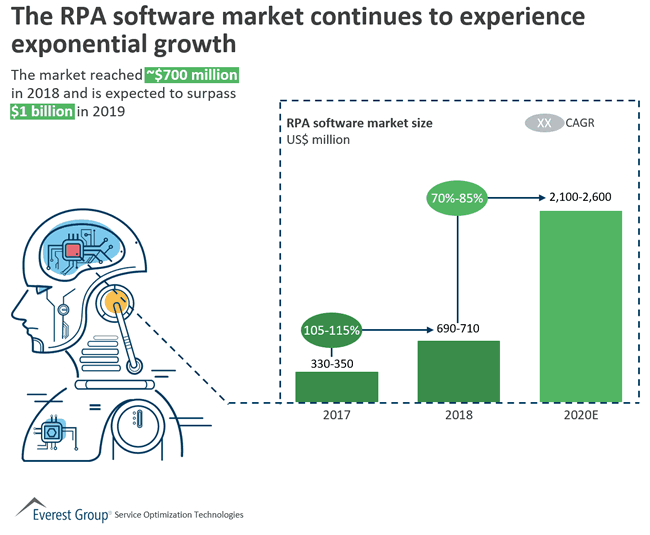
All images and data are property of their mentioned owners. Top image and ‘RPA benefit word image’: Shutterstock – Copyright: iQoncept
